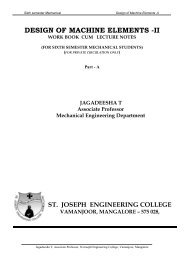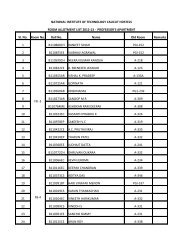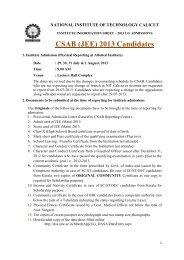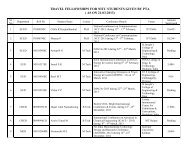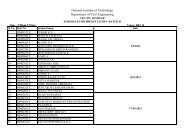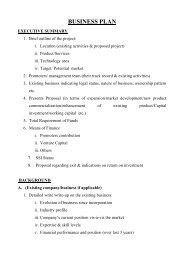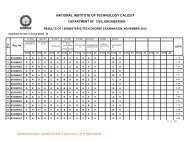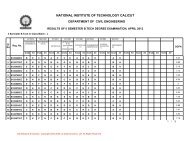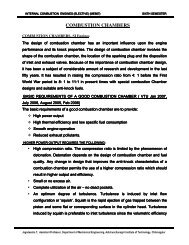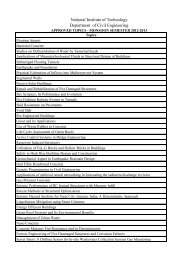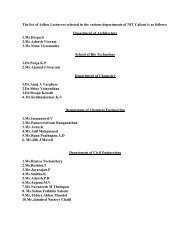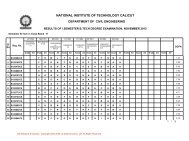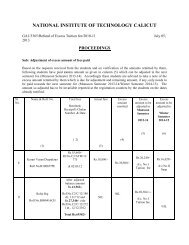unit 2 design of single point cutting tools
unit 2 design of single point cutting tools
unit 2 design of single point cutting tools
Create successful ePaper yourself
Turn your PDF publications into a flip-book with our unique Google optimized e-Paper software.
Design <strong>of</strong> Cutting<br />
Tools and Holding<br />
Devices<br />
SAQ 4<br />
(a)<br />
(b)<br />
t1<br />
Length <strong>of</strong> shear zone, L s =<br />
sin φ<br />
(c)<br />
(d)<br />
(e)<br />
(f)<br />
2<br />
= = 4 mm<br />
sin 30<br />
Discuss various forces involved in machining operation.<br />
How one can <strong>design</strong> tool shank<br />
−1<br />
Ft<br />
Derive Frictional angle, β=α+ tan<br />
⎡ ⎢ ⎤<br />
⎥ .<br />
⎣ Fc<br />
⎦<br />
Derive expression for power required during machining.<br />
Following data obtained during machining <strong>of</strong> mild steel with <strong>single</strong> <strong>point</strong><br />
HSS tool rake angle <strong>of</strong> tool = 10 o , uncut chip thickness = 0.3 mm, width <strong>of</strong><br />
cut = 2 mm, shear plane angle = 36 o , shear strength <strong>of</strong> mild steel<br />
= 450 MPa. Using Merchants analysis find out the coefficient <strong>of</strong> friction<br />
between the chip and tool. Also calculate shear force in <strong>cutting</strong>.<br />
A 0.2% carbon steel is machined with a triple carbide <strong>cutting</strong> tool having<br />
0-10-6-6-8-75-1mm ORS shape, a feed <strong>of</strong> 0.15 mm/min have been<br />
employed. A chip thickness <strong>of</strong> 0.36 mm has been obtained. Calculate chip<br />
thickness coefficient and shear angle.<br />
2.6 SUMMARY<br />
Strength and rigidity are the important parameters while <strong>design</strong>ing the shank <strong>of</strong> the<br />
<strong>cutting</strong> tool. Forces and power consumption decreases with increase in positive back rake<br />
angle. A positive back rake angle is responsible to move the chip away from the<br />
machined workpiece surface. The tool material should have high wear resistance, hot<br />
hardness, hardness, toughness, thermal conductivity, and low coefficient <strong>of</strong> thermal<br />
expansion. Cutting force, feed force and shear force acts on the workpiece and <strong>cutting</strong><br />
force is the largest <strong>of</strong> these three forces. Dynamometers are used for measuring tool<br />
forces with great accuracy.<br />
2.7 KEY WORDS<br />
Back Rake Angle<br />
Cutting Force<br />
Merchants Circle<br />
: It is the angle between face <strong>of</strong> the tool and a line<br />
parallel with the base <strong>of</strong> the tool. It moves the chip<br />
away from the machined workpiece surface.<br />
: The component <strong>of</strong> forces acting on the rake <strong>of</strong><br />
tool, normal to the <strong>cutting</strong> edge and in the<br />
direction <strong>of</strong> <strong>cutting</strong> velocity. It is the largest <strong>of</strong><br />
three forces <strong>of</strong> component.<br />
: Used to determine forces.<br />
2.8 ANSWERS TO SAQs<br />
Refer the relevant text in this <strong>unit</strong> for answer to SAQ.<br />
SAQ 4<br />
(e) μ = 0.531, shear force = 460 N.<br />
(f) chip thickness coefficient = 2.64, shear angle = 21.76 o .<br />
34



